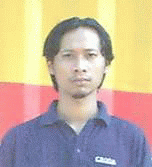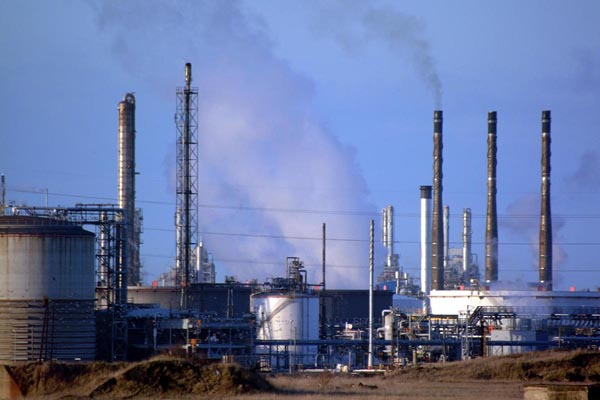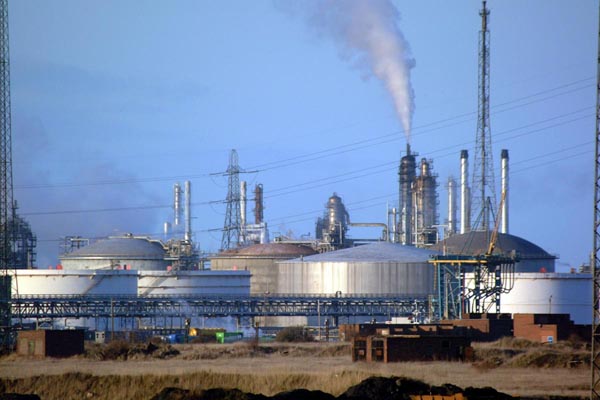|
|
PT. Krakatau Steel
(KS) is state-owned steel industry located in Cilegon,
approximately 100km west Jakarta . KS is the largest
steel industry in indonesia, with integrated plants producing
various steel product such as billet, slab, wire rod, and
sheet/coil. The total capacity of KS is around 2.500.000
ton per annual. KS industrial compolex comprises seven
different plant/mill direct reduction plant, two slab steel
plants, billet steel plant, hot strip mill, wire rod mill, and
cold rolling mill.
In production tonnage, KS represent around 50% country
capacity. Largest portion of KS production is of steel
sheet/coils, both of hot/cold rolled coils. KS produce
HRC ( Hot Rolled Coil ) around 1.9 million ton, and around 40%
of which are further rolled at the Cold Rolling Mill |
|
|
PT. KRAKATAU STEEL |
|
|
|
MELTING PROCESS |
|
ROLLING PROCESS |
| |
|
DR
DIRECT REDUCTION |
HSM
HOT STRIP MILL |
| |
|
SSP
SLAB STEEL PLANT |
CRM
COLD ROLLING MIL |
| |
|
BSP
BILLET STEEL PLANT |
WRM
WIRE ROD MILL |
| |
|


The total reduction for the realization of steels coil is imposed by the
metallurgical road, it must be imperatively respected
The reduction at the last stand is imposed by the aimed strip roughness,
which must be between 0.6 and 1.1 micron for steel of
quality
( Target value = 0.85 ).
For the first four stands, it is common to use reductions which balance
the power of stands, in order to maximize the productivity . However this
rule may not applicable for reason of :
These two parameters must have priority in the case they
are close to their limit.
* Mini hardness : 57 shore C
Back-up roll crown and back-up roll edge drops must be adjusted to
obtain a good interstand and exit flatness. The adjustment values depend
on the equipment a very detailed attention must be given to the grinding
process to deeply reduce the roll eccentricity :
-
The journal grinding should be the same, if possible,
than the journal during rolling, if not their concentricity must be
maintained perfect.
-
In the case that bearing are oil film ones, the use of
the key less designed ones is recommended
-
Drive unbalances of the grinding machine must be avoid
Before the roll mounting into the stand, please check :
In that even of defect, refuse the rolls.
* Mini hardness : 86 shore C
The work roll crowns must be adjusted to obtain an interstand and exit
flatness of the slight long edge type " The adjustment values depend on
the equipment.
it may be necessary to have specific work roll crowns to roll steel
products, in particular for the last stand . All depends on the ranges of
effectiveness of the positive and negative bending and of the other
flatness actuator , if any.
It is preferable that the stand 1 work roll are crome plated
the rougness of the last stand must be carried out by EDT
process, its values is imposed by the aimed strip roughness , who must be
between 0,6 and 1,1 micron for steel of quality ( Target value = 0,85).
Usually, to satisfy this requiredment, the roughness of the last stand must
be in the range of 2,7 to 3 micron Ra.
After the roll mounting into the stand and before rolling ,
the roughness peaks of the last stand roll must be slightly furbished by
rotating the roll at 15 m/minutes , during 2 minutes , under a rolling
force of 500 tonnes.
During the grinding operation , a very detailed attention
must be given to reduce at a maximum the out of roughness which may be
created by the grinding drive unbalances
Before the roll mounting into the stand , check :
-
That their surface appearance does not present any
defect which can affect the quality of the coils to be rolled.
-
That the roll crowns correspond to that which was
programmed.
-
That the roughness of the rolls correspond to that which
was programmed.
In the even of defect , refuse the roll.
The main dimensioning parameter are :
- The minimum flow which must be at least equal in litre/minute to the
installed power in kw.
- The pressure level of the spray feeding lines which must range
between 2 and 6 bars.
The main parameters to be monitored are :
- The oil concentration which has to be controlled at least once per
shift, it must be stable within +/- 20% , by comparison to target value.
That the nominal given below are indicates, they may have to adapted
accoring to the obtained cleanliness result :
- For stands 1 and 2, concentration higer han 1.8% ( Ranging
between 1.8% - and 3% )
- For stands 3 and 4, concentration lower than 1.8% ( Ranging
between 1.5% and 1.8% )
- For stan 5, concentration lower than 1% ( ideal 0.7%)
-
The sponification number gas to be controlled at least
once by shift. its nominal values is often ranging between 130 and
150 ( to be adapted according to the obtain ed cleanliness result )
. It must be maintained within +/- 10%, by comparison to its
target values.
-
The temperature measured near the stand , upstream of
the lubrication system spray valves, must be monitored by a temperature
control loop within a tolerance of =/-2 C , compared to the aimed
temperature . This target values depends on the lubrication . Its often
close to 50C.
-
The iron content inside the emulsion of the last stand
must have a values lower than 60 mg/l , for that it is recomended to
filtr totality
of the emulsion flow of the last stand throught a magnetic filter.
-
There should not be particles of more than 250 micron in
the emulsion at the level of the lubrication feeding lines, it is those
recommended to install 250 micron filters upstream of them.
-
The PH has to be supervised once by shift, it should not
record signicicant variations
POSITIVE AND NEGATIVE
BENDING
The positive and negative bending must be adjusted to control the
interstand and exit flatness of the tandem mill. the variation range must
be enough to carry out this objective.
The longitudinal thickness must be accurately controlled, for that is
essencial that the thickness gages are callibrated as follow.
- After any stoping of the rolling mill for maintenace
- After each roll change
- After any mill stop higher than 30 minutes.
- At each begining of shift
When two thickness gages are installed at the exit of last stand they
must be under simultaneous operation each time it is possible.
Any variation of more than +/-2% between the two gages must lead to the
following actions :
- To stop rolling
- To block the coil
- To clean and callibrate the two gages
If the problem persist it is necessary to repair , after having
detected the gage which is giving a bad measurement of the coil diameter
on
the coiler. The longitudinal thickness must be recorded for ecah strip,
over all it lenght. The thickness tolarance is given by customer, if not,
a tolerance of +/-4% must be taken into account.
- The thickness is out of the tolerance in the strip body , except at
the end (100 m at both ends)
- Or if the head plus tail out gage lenght exceeds 50m.
Other constraint related to the thickness :
- There should not be weld inside coils.
- Every coil must have experienced an audible chattering must be
blocked.
- Every coils having experienced a line stop must be divide ( if the
lenght of one of the two parts is still sufficient ) or be blocked ( if
not )
For the needs of the downstream process, the strip at exit of the tandem
mill must be symmetrical, with slight long edges. The crinkled
edges are prohibited.
The two following flatness criteria must be recorded over each strip
lenght :
- Total flatness.
- differential flatness.
The total flatnes must be such as it is not seen at the
tandem mill exit, it must those be lower than 20 UI ( Flatness become
latent under a minimal tension of 4 kg/mm2
The differential flatness must be lower than 10 UI, in case one of the
flatness criteria exceeds its allowed value over a strip lenght more than
100m ( except 10 m at head and tail ends ), the coil must be blocked.
If the bad flatness is persistent, it is necessry to change the work roll
of the last stand. If the change of the work roll did not solve anything ,
the back-up roll should be changed.
The aimed flatness in the interstands must also be with slight long edge,
to avoid edge crack.
|





